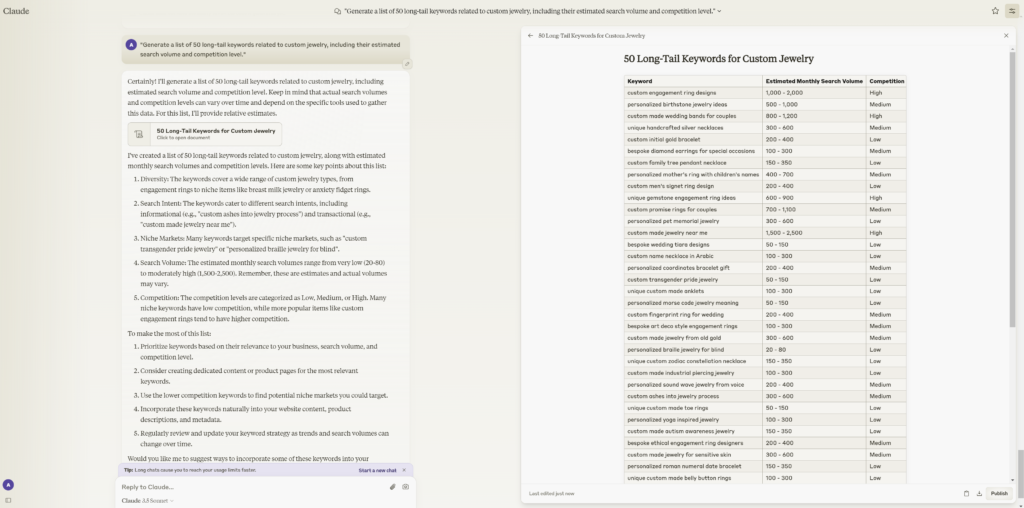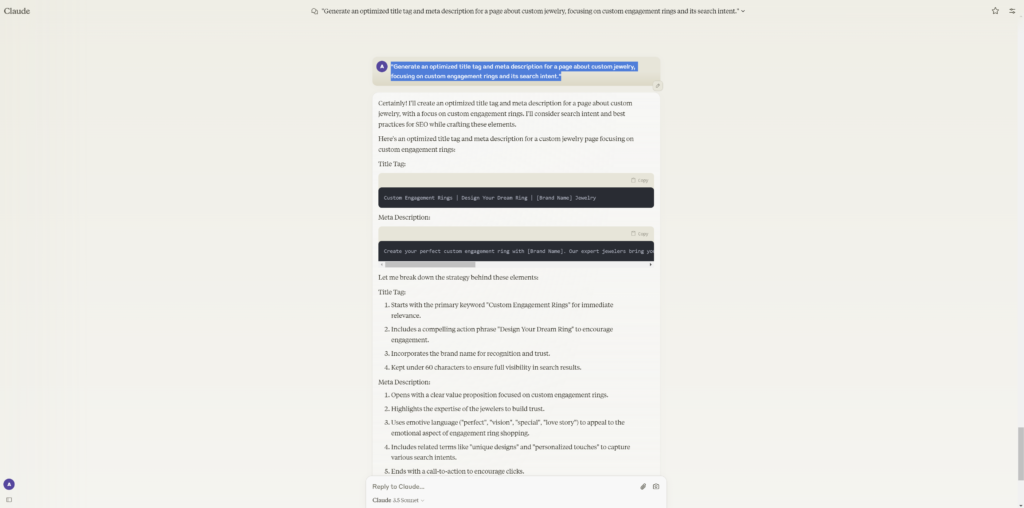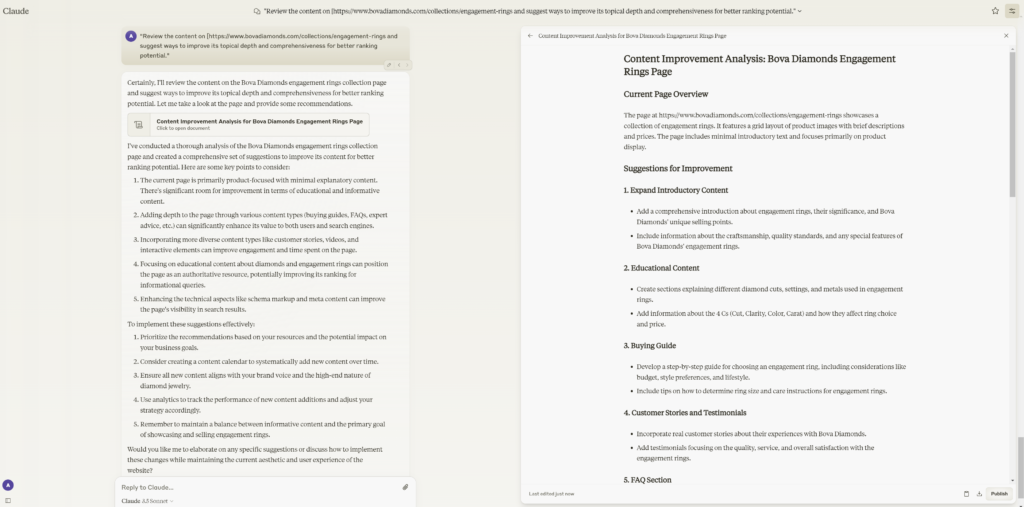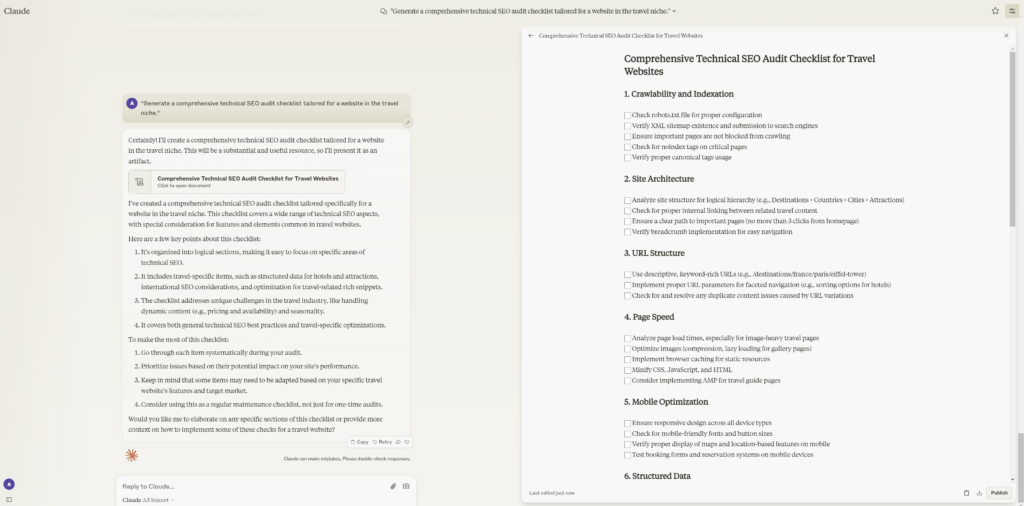Many people in the world know ChatGPT well. But there are few other al
Want to supercharge your SEO workflow with Claude AI?
You’re in the right place.
In this guide, I’m going to share the exact Claude prompts that have helped me (and thousands of other SEO professionals) streamline our keyword research, content creation, and technical optimization.
In fact, these prompts have saved me about 10-15 hours per week on SEO tasks alone.
Let’s dive right in.
Why Claude Beats ChatGPT for SEO Tasks
Look, I’ll be straight with you.
While most people are still obsessed with ChatGPT, I’ve been quietly using Claude for my SEO work for months now.
Here’s why Claude is actually better for SEO:
First, Claude handles longer, more complex prompts without losing context. This is HUGE when you’re doing competitive analysis or content planning.
Second, Claude’s training data seems more recent and comprehensive for SEO-related topics. I’ve noticed it gives more accurate technical advice.
Third, Claude is less likely to give you those generic, cookie-cutter responses that sound like they came from a content farm.
But here’s the thing…
Claude is only as good as the prompts you feed it.
That’s exactly why I put together this list of battle-tested prompts that actually work.
The 6 Categories of SEO Prompts That Actually Move the Needle
After testing hundreds of different prompts, I’ve found that the most effective ones fall into these 6 categories:
- Keyword Research (the foundation of everything)
- Competitive Analysis (spy on your competitors legally)
- On-Page SEO (optimize what Google sees)
- Content Optimization (make your content irresistible)
- Technical SEO (the behind-the-scenes magic)
- Content Creation (scale your content production)
Let’s break down each category with the exact prompts I use.
1. AI Promts – Keyword Research
Keyword research is still the backbone of SEO success.
But here’s what most people get wrong: They focus on high-volume keywords that are impossible to rank for.
Smart SEO professionals focus on finding the “low-hanging fruit” – keywords with decent search volume but lower competition.
Here are the prompts that help me find these hidden gems:

The Long-Tail Goldmine Prompt
Generate a list of 50 long-tail keywords related to [main topic], including their estimated search volume and competition level.Why this works: Long-tail keywords are easier to rank for and often have higher conversion rates.
The Trend Predictor Prompt
Identify emerging keyword trends in the [industry] niche for the next 6 months based on current search patterns and industry developments.Pro tip: Use this to get ahead of your competition by targeting keywords before they become saturated.
The Question-Based Opportunity Finder
Suggest 20 question-based keywords that our target audience might use when searching for information about [topic].Why this matters: Question-based keywords are perfect for featured snippets and voice search optimization.
The Competitor Gap Analysis Prompt
Analyze the keyword gap between our website and our top 3 competitors, identifying opportunities we're missing.This is powerful because: You can literally steal your competitors’ traffic by targeting keywords they rank for but you don’t.
The LSI Keyword Expander
Create a list of LSI (Latent Semantic Indexing) keywords for [primary keyword], explaining how each relates to the main topic.The Cannibalization Detector
Identify potential keyword cannibalization issues within our website for [topic] and suggest how to resolve them.Important: Keyword cannibalization can seriously hurt your rankings. This prompt helps you catch it early.
2. Competitive Analysis – AI Promts
Want to know a secret?
Your competitors are leaving breadcrumbs all over the internet that show you exactly how to beat them.
You just need to know where to look.
These prompts turn Claude into your personal competitive intelligence agent:
The SERP Analysis Prompt
Analyze the top 5 ranking pages for [keyword] and break down their content structure, word count, and key on-page SEO elements.What this reveals: The exact content format Google rewards for your target keyword.
The Backlink Gap Finder
Compare our backlink profile with our top 3 competitors for [keyword] and identify link-building opportunities we're missing.Why this is gold: Backlinks are still a major ranking factor. This shows you exactly where to focus your link building efforts.
The Content Gap Analyzer
Examine the content gaps between our website and the top-ranking competitors for [topic], suggesting unique angles we could cover.The benefit: Find untapped content opportunities that your competitors are ignoring.
The Social Media Strategy Decoder
Analyze the social media strategy of our top competitor in the [industry] niche, identifying their most engaging content types and topics.The Site Structure Inspector
Compare the site structure and internal linking strategies of the top 3 ranking websites for [keyword] with our own, suggesting improvements.The UX Differentiator
Identify the key differentiating factors in terms of content and UX for the top-performing pages in [niche] compared to ours.3. On-page SEO – AI Promts
On-page SEO is like dressing up your content for a first date with Google.
You want to make the best possible impression.
These prompts help you optimize every element that Google cares about:

The Title Tag & Meta Description Optimizer
Generate an optimized title tag and meta description for a page about [topic], focusing on [primary keyword] and its search intent.Remember: Your title tag is often the first thing people see in search results. Make it count.
The Header Structure Architect
Suggest a hierarchical heading structure (H1, H2, H3) for a comprehensive guide on [topic], incorporating relevant keywords naturally.Pro tip: Good header structure makes your content easier to scan and helps Google understand your page organization.
The Internal Linking Strategist
Create a list of internal linking opportunities for a new blog post about [topic], including anchor text suggestions and target URLs.Why this matters: Internal links distribute page authority throughout your site and help users discover more of your content.
The Alt Text Optimizer
Optimize the alt text for 10 images in an article about [topic], ensuring they're descriptive and incorporate relevant keywords.The URL Structure Fixer
Suggest improvements for the URL structure of our website's [section], focusing on SEO best practices and user-friendliness.The Schema Markup Enhancer
Analyze our current use of schema markup and suggest additional types and properties we could implement to enhance rich snippets for [type of content].4. Content Optimization – AI Promts
Think of it as tuning up your content so it hits all the right notes with both Google and your actual human readers. It’s not about tricking anyone; it’s about making your stuff genuinely awesome and easy to find.
You know how you’d jazz up a boring story to keep your friends from zoning out? That’s kinda what we’re doing here. We’re taking your content and making it pop. We’re talking easier to read, up-to-date info (because nobody likes stale news), and seamlessly working in those keywords people are actually searching for.
But here’s the thing – it’s not just about cramming in buzzwords. It’s about making your content flow so naturally that people actually want to stick around and read it. And hey, if Google happens to love it too, that’s a nice bonus, right?

- “Review the content on [URL] and suggest ways to improve its topical depth and comprehensiveness for better ranking potential.“
- “Identify opportunities to naturally incorporate [primary keyword] and its semantic variations in the existing content at [URL] without keyword stuffing.“
- “Suggest ways to update and refresh an old blog post about [topic] to improve its relevance and SEO performance.“
- “Analyze the content structure of [URL] and recommend improvements to enhance readability and user engagement (e.g., adding subheadings, bullet points, or multimedia elements).“
- “Identify sections in the content at [URL] that could benefit from adding statistical data or expert quotes to improve E-A-T signals.“
- “Suggest ways to optimize the introduction and conclusion of the article at [URL] to improve user engagement and reduce bounce rate.“
5. Technical SEO – AI Promts
Think of technical SEO as giving your website a full-body tune-up. It’s like making sure your car’s engine is running smoothly so you can actually get places, you know?
We’re talking about all the behind-the-scenes stuff that makes your site work like a dream. It’s about making sure Google’s little search bots can zip around your site without hitting any roadblocks.

- “Generate a comprehensive technical SEO audit checklist tailored for a website in the [industry] niche.“
- “Suggest improvements for the current XML sitemap structure of [website], focusing on optimal categorization and priority settings.“
- “Identify potential issues in the current robots.txt file of [website] and suggest optimizations to improve crawlability while protecting sensitive content.“
- “Analyze the current URL parameter handling on [website] and suggest ways to prevent duplicate content issues.“
- “Recommend a strategy for implementing AMP (Accelerated Mobile Pages) on [website], including which types of content should prioritize AMP versions.“
- “Suggest a step-by-step process for migrating [website] from HTTP to HTTPS, including key considerations for maintaining SEO performance during the transition.“
6. Content Creation – AI Promts
- “Develop an outline for a comprehensive, 3000-word guide on [topic], including key sections, subsections, and the main points to cover in each.“
- “Generate 20 engaging blog post title ideas for articles related to [topic], incorporating relevant keywords and addressing user intent.“
- “Create a content brief for a data-driven article about [topic], including suggestions for data sources, key points to cover, and potential data visualization ideas.“
- “Suggest a structure for a 10-minute video script about [topic], optimizing it for both user engagement and YouTube SEO.“
- “Develop ideas for a series of interlinked blog posts about [broad topic], including how they should link to each other and support the overall topic cluster.“
- “Create a month-long social media content calendar to promote a new comprehensive guide about [topic], including post ideas for different platforms and optimal posting times.“
Is a senior SEO expert with over a decade of experience dominating the digital marketing battlefield. Since 2023, I’ve been riding the AI wave. Since 2024, I have started to work with the SEO Bazooka Blog.

Leave a Reply